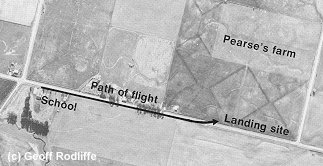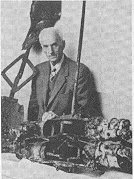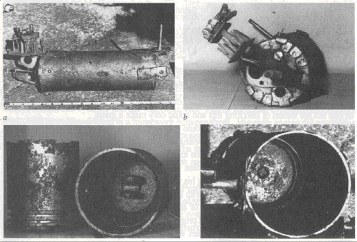 |
 |
| Richard Pearse | A replica of
Pearse's aeroplane. Modern Ultralights look like it. |
Richard Pearse
 |
 |
| Richard Pearse | A replica of
Pearse's aeroplane. Modern Ultralights look like it. |
Many aviation pioneers have claimed to be the
first to fly. New Zealander Richard Pearse, who lived from December 3rd 1877 to
July 29th 1953 is said to have flown before Orville and Wilbur Wright. I mean a
powered flight.
However, much is unclear about this event. Richard Pearse was a good inventor, a
little unusual person who was ahead of his time. Most of his inventions were in
the field of machinery for agricultural use. In those days a person like
Richard would be called "a mad scientist". Other nicknames were "Mad Pearse"
and "Bamboo Dick".
Pearse was the son of a farmer and he started working at his own farm in 1898 at a piece of 40 acres land in Waitohi, South Canterbury, New Zealand. Since he was more interested in technique as in farming, he was not a very dedicated farmer. But the advantage of being a farmer is the fact that one can do a lot of work by which you have all the time to think. That worked out well for Richard. In 1902 he patented a special drive for bicycles and tyres which inflated themselves. Then he designed a two cylinder petrol engine which he mounted on a tricycle. To the tricycle he fixed a wing and there was his aeroplane! All his flying efforts led to nowhere. Then, he made his engine more powerful. This was an exceptional engine. There were burning chambers on both sides of the pistons. This engine was really ahead of his time. Sixty years later people found the remnants of his engine in a heap of junk and restored it. This engine delivered 15 to 22 horsepower.
There is strong evidence Pearse has flown on March
31st of 1903. But he himself thought he had left the ground, but the speed was too low to use the controls well. He stayed airborne for an
instant before crashing in a hedgerow. It seems he flew at a height of three
meters. (At the right is a photo which shows his first flight, from the school
to his land).
the speed was too low to use the controls well. He stayed airborne for an
instant before crashing in a hedgerow. It seems he flew at a height of three
meters. (At the right is a photo which shows his first flight, from the school
to his land).
Little is written about his flight. There are no paper articles left too.
Some photos remain, but the date is unknown and some photos show something
that is not very clear to interprete. Pearse stated contradictionary explanations,
of which people concluded that he flew in fact in 1904.
In 1911 Pearse moved to Milton and ended the flying experiments because that town was situated in a hilly terrain. Many of his experimental products were thrown in a rubbish pit. He then moved to Christchurch in the twenties of the previous century, where he built three houses and started to live of the interest.
In the decades afterwards he kept on experimenting with aeroplanes. He built fantastic aero engines, including a helicopter engine. At the end of his life he was troubled by a persecution complex. He was convinced foreign spies would discover his work. He was placed in an asylum and died two years later, in 1953. Many of his papers most likely disappeared in that period.
 Aviation
pioneer George Bolt (left with the remnants
of the Pearse engine) dug up the rubbish pit in Waitohi and discovered all kinds
of materials, like a propeller. In the sixties he came up with evidence of
Pearse's flight thanks to witnesses who were schoolkids in 1903. People who left
the region in 1904 remembered the flight because they witnessed it. They also
remembered the flight of July 10th 1903, in midwinter (New Zealand
is situated in the southern hemisphere, so seasons are opposite).
Aviation
pioneer George Bolt (left with the remnants
of the Pearse engine) dug up the rubbish pit in Waitohi and discovered all kinds
of materials, like a propeller. In the sixties he came up with evidence of
Pearse's flight thanks to witnesses who were schoolkids in 1903. People who left
the region in 1904 remembered the flight because they witnessed it. They also
remembered the flight of July 10th 1903, in midwinter (New Zealand
is situated in the southern hemisphere, so seasons are opposite).
Richard Pearse himself did not contribute much to provide clarity about the
exact date of his flight. In two letters, from 1915 and 1928 he mentions
February or March 1904 as the time he solved the problems with control. He
further stated that he did not really fly and he had not beaten the Wright
brothers (to be the first).
Yet many witness reports mention March 31st 1903.
The distance people recall range from 45 to 320 meters.
Pearse did not realize that his first flight was an important event, so no
photos are made. Probably he did not care to be the first in history or not. He
just wanted to fly...
|
|
| This design is hard to read, but
it shows how flat Richard Pearse's engine was. There are two cylinders, one at the left and one at the right. What makes this design special, is the fact that each cylinder has to burning hambers. This makes the engine powerful and yet lightweight. |
It is peculiar
that a New Zealander made the first flight, nine months before the Wrights and
nobody in the world knew about it. Telegraph existed already, as telephone and
papers, especially in the United States, were filled up with aviation news. At
many places experiments with aeroplanes were taking place. This event of Richard Pearse
would have become known. News really travelled fast in 1903.
Opposite, Richard Pearse knew very well what was going on in the world of
aviation and the progress made because he read "Scientific
American".
The fact he gets a lot of interest on these pages
is because he designed a special monoplane with a special engine.
Even if he would have made his first flight in 1904, he would not have been the
first, but he had built the first modern aeroplane in history!
Most likely his aeroplane was better than all French aeroplanes before roughly
1910.
|
|
| A replica, built in the seventies.
It serves as a monument for Richard Pearse. The aeroplane has three wheels and was monoplane, which was quite modern in 1903/1904. His machine has ailerons which work better than the flexing wings of the Wright Flyer. The monument is situated in Waitohi. |
 The
materials of which the aeroplane of Pearse was built consisted of bamboo, steel
tubes, steel wire and fabric. The engine, of which the remnants were found later
(see left) was ahead of its time. A similar engine was built by the Germans much
later, but then it was nearly 1940.
The
materials of which the aeroplane of Pearse was built consisted of bamboo, steel
tubes, steel wire and fabric. The engine, of which the remnants were found later
(see left) was ahead of its time. A similar engine was built by the Germans much
later, but then it was nearly 1940.
After all the facts, the question remains if
Richard Pearse was earlier in making a motorized flight than the Wrights.
Unfortunately all witnesses have died.
Maybe some day more evidence is found.
Richard Pearse has definitely deserved his place in the history of aviation!
Hans Walrecht